Archive : Article / Volume 1, Issue 1
- Research Article | DOI:
- https://doi.org/10.58489/2836-2187/001
Quorum Sensing Based Drug Screening Against Vibrio Cholerae
1.Department of Food Science & Nutrition, Nehru Arts & Science College, Coimbatore.
2.Department of Food science and Nutrition, Mount Carmel College, Autonomous, Bengaluru, Karnataka 560052, India.
3.Sri Lakshmi Narayana Institute of Medical Sciences, Puducherry â 605 502 (affiliated to Bharath Institute of Higher Education and Research (BIHER), Chennai, Tamilnadu), India.
Kothandapani Sundar
Mahima M, Kumara G. K, P. Vasanthakumari, G. Jayalakshmi, K. Sundar, (2022). Quorum Sensing Based Drug Screening Against Vibrio Cholerae. Journal of Microbes and Research. 1(1). DOI: 10.58489/2836-2187/001
© 2022 K. Sundar, this is an open access article distributed under the Creative Commons Attribution License, which permits unrestricted use, distribution, and reproduction in any medium, provided the original work is properly cited.
- Received Date: 19-08-2022
- Accepted Date: 02-09-2022
- Published Date: 27-09-2022
Bioactive compounds, Quorum Sensing Inhibitors (QSI), Vibrio cholerae, Nosocomial infection, Molecular Docking.
Abstract
The QS method is a means of bacterial cell-to-cell communication, which uses extracellular signal molecules called autoinducers to transmit information between cells.Bacteria can use QS to collaborate on tasks. The pathogen Vibrio cholerae uses QS to inhibit the development of virulence factors and the formation of biofilms. Cholera is caused by the Gram-negative, curved bacteria Vibrio cholerae (Clemens et al., 2017). There are also a number of virulence components produced by this disease, including cholera hemolysin (CH), toxin-co-regulated pilus (TCP), flagellum, etc. By constraining the target protein, HapR, with adequate bioactive compounds, the pathogenic activity of in vibrio cholerae can be suppressed.Bioactive substances from various natural food sources were chosen and analysed for their quorum quenching effect against HapR protein utilising bioinformatics methods. The in-silico analysis produced notable results for thirteen of the 25 substances evaluated, with the best docking score. These chemicals could be employed for QSI-based therapeutics against vibrio cholerae infections and could be suggested for in vitro and in vivo investigations.
Introdution
Bacterial communication, referred to as quorum sensing, involves cells altering gene expression based on growth rate (Ng and Bassler, 2009; Papenfort and Bassler, 2016). Autoinducers are tiny compounds secreted by Gram-negative bacteria that operate in quorum sensing (Ng and Bassler, 2009; Papenfort and Bassler, 2016). In contrast, high cell density is associated with adequate levels of autoinducers to attach to receptors and start signaling cascades.It is known that V. cholerae produces and responds to four autoinducers (Jung et al., 2015, 2016). Every autoinducer binds to its cognate kinase at high cell density, causing the LuxO regulator to be dephosphorylated (Jung et al., 2015). In the end, the expression of four short regulatory RNA (Qrr sRNAs) is inhibited, while the translation of the HapR regulator protein is initiated (Ng and Bassler, 2009; Jung et al., 2015) Shao and Bassler (2014) show that Qrr sRNAs directly bind to the 5' UTR of the mRNA generated from the T6SS cluster in V. cholerae strain C6706, inhibiting translation (Shao and Bassler, 2014). Tsou et al., 2009; Shao and Bassler, 2014; Watve et al., 2015) found that HapR binds to auxiliary cluster promoters to boost transcription. The diarrheal disease cholera is caused by Vibrio cholerae, a Gram-negative, curved bacteria (Clemens et al., 2017). This pathogen produces a number of important virulence factors, including cholera toxin (CT), toxin co-regulated pilus (TCP), flagellum, and cholera hemolysin.
In hospitalised patients, nosocomial infection is the most common complication. Even after adjusting for underlying illness, HAIs increase morbidity, mortality, expenses, and length of stay (Sydnor ERM and Perl TM 2011). The phrase nosocomial infection refers to a smaller range of infections. As defined by Syndnor ERM and Perl TM (2011), nosocomial infections in the hospital are those acquired before the patient becomes ill or is incubating at the time of admission.According to figures from 2003, 5 to 10% of patients admitted to acute-care hospitals in the United States, or around 2 million patients each year, contract a nosocomial illness. Acute diarrheal illness is a leading source of morbidity and mortality in underdeveloped nations, particularly among children. Insufficient removal of human waste and poor hygienic conditions can lead to nosocomial transmissions in healthcare facilities. As little as a few hours can pass between patients who develop severe diarrhea, dehydration, shock, and death after contracting Vibrio cholerae, a gram-negative bacterium that produces enterotoxins.A central role for biofilms has been identified in Vibrio cholerae pathogenesis, since the bacterium becomes antibiotic-tolerant and hyperinfectious through the presence of biofilms (Kierek and Watnick 2003; Tamayo et al. 2010; Yang et al. 2010; Sambanthamoorthy et al. 2012).It has already been demonstrated that HapR suppresses TCP and CT in part through repression of AphA, however it remains to be seen whether HapR can directly repress the genes involved with ToxR virulence. Moreover, the mechanisms that trigger Fur-mediated TCP expression are not understood.Gao et al., 2018) showed that HapR directly regulates fur transcription, and HapR works together with Fur to regulate hlyA transcription, suggesting that Fur is integrated in QS for co-regulation of gene expression in V. cholerae.
The role of various probiotics content in dairy products in improving and avoiding gastrointestinal and other disorders, as well as the importance of various food components in reducing various diseases, have all been proven in research. Several studies have demonstrated the value of tailored diets based on an individual's risk category and the health advantages they provide. Many studies have revealed that various crude extracts from food products aid in the quick clearing of microorganisms, indicating the presence of active quorum-sensing inhibitor components in many food sources. According to research done by Zimmer et al. (2014), blueberry fruit extracts demonstrated significant effectiveness against S. epidermidis biofilm without affecting bacterial development.Several studies have found prospective chemicals that can control or inhibit quorum sensing. However, these investigations are restricted, and there are still many substances that can be employed for quorum quenching. People's well-being can be aided by studying these food-derived components, so more research is required in this area. In the current work, natural food components were tested for their quorum sensing inhibitory action against the HapR target of vibrio cholera using computer aids such as virtual screening and molecular docking. These methodologies may allow us to uncover possible anti-QSI compounds against HapR vibrio cholera, which can then be studied in vitro and in vivo and potentially employed as a food-based medication to treat drug-resistant vibrio cholera infections.The current study aims to investigate the quorum sensing inhibitory activities of edible bioactive compounds against nosocomial infection causing medication resistant Vibrio cholerae using an in silico technique.
Materials and Methods
Selection of bioactive compounds:
To further understand docking interactions between edible bioactive substances and vibrio cholerae (HapR) quorum sensing controlled proteins, a molecular docking analysis was undertaken using AUTODOCK. Table 1 lists bioactive components from various foods that were chosen based on past research findings.
Table 1: Food Source and bioactive compounds
| FOOD SOURCE | BIOACTIVE COMPOUNDS |
| Milk | Bovine Lactoferrin |
| Green tea | (-) - epicatechin (EC) |
| (-) – epicatechin-3-gallate (ECG) | |
| (-)-epigallocatechin (EGC) | |
| (-)-epigallocatechin-3-gallate (EGCG) | |
| Zingiber officinale | 6-gingerol |
| 8-gingerol | |
| 10-gingerol | |
| Curcuma amada | Cinnamic acid |
| Ferulic acid | |
| P-coumaric acid | |
| Protocatechic acid | |
| Gentisic acid | |
| Gallic acid | |
| Orange | Naringin |
| Neohesperidin | |
| Hesperidin | |
| Grapes | Rasveratrol |
| Lemon | D-Limonene |
| Limonexic acid | |
| Mango | Mangiferin(2-β-D-glucopyranosyl-1,3,6,7-tetrahydroxy-9H-Xanthen-9-one) |
| Pumpkin, Chilli, Eggplant | Zeaxanthin |
| Fish | Docohexaenoic acid |
| Eicosapentanoic acid | |
| Cauliflower | Quercetin |
Retrieval of 3D Structures of Target and food compounds
Protein Data Bank (PDB):
The Protein Data Bank (PDB; http://www.rcsb.org/pdb/) is a global database that contains three-dimensional structural data for biological macromolecules such as proteins and nucleic acids. These structures are generally accessible and have been submitted by scientists using biological techniques like as X-ray crystallography, NMR spectroscopy, and cryo-electron microscopy. We employed the structure of a known anti-quorum sensing chemical coupled to our preferred target protein (PDB ID: 6D7R) as well as high resolution three-dimensional structures of the target protein (PDB ID: 6D7R) from the PDB library in this paper.
PubChem
Millions of compound shapes and descriptive information can be freely downloaded through FTP by PubChem (https://pubchem.ncbi.nlm.nih.gov), a public chemical information database run by the National Center for Biotechnology Information (NCBI). Substance, Compound, and Bioassay are the three databases that PubChem uses to organize the information. We're going to use the PubChem database to have the structures of 25 food-derived compounds. The downloaded structures are in SDF format, which can be transformed to MOL2 for docking using chimaera.
2.3. Molecular Docking of Bioactive Compounds to Target by AutoDock
The interaction between molecules is at the basis of most biological properties. These molecules might be proteins, enzymes, or therapeutics, and the best result comes from a good interaction between them. Docking is the software's prediction of these connections. Docking is a molecular modelling technique that aids in predicting how well a protein interacts with a ligand molecule. Docking methods are incredibly beneficial in a variety of biological research areas, and we definitely require some docking software to carry out these procedures.AutoDock is a collection of docking automation tools. Its goal is to anticipate how smaller compounds, such as substrates or medication candidates, would bind to a 3D-structured receptor. It has been changed and upgraded throughout time to provide new features, and many engines have been created.AutoDock is a simulation software for molecular modelling. It's particularly useful for protein-ligand docking. The GNU General Public License applies to AutoDock 4. AutoDock is one of the most widely used docking software programmes in academia. (Sousa SF et al. 2006), It is utilised to search for antivirals against HIV/AIDS and COVID-19 by the World Community Grid Projects Fight AIDS@Home and Open Pandemics - COVID-19. AutoDock is made up of two programmes: (Park H, Lee J, et al., 2006) AutoDock for ligand docking to a collection of grids characterising the target protein; AutoGrid for pre-calculating these grids. AutoDock has aided in the development of a number of medications, including HIV-1 integrase inhibitors. (Goodsell DS, et al., 2020, Schames JR, et al., 2004, Gupta G (2020-05-26). Linux, Mac OS X, SGI IRIX, and Microsoft Windows are all supported by AutoDock.
2.4. In-vitro studies for quorum sensing inhibition (QSI) activity
2.4.1. Minimum inhibitory concentration (MIC) of Epigallocatechin3gallate (EGCG) and Neohesperidin against Vibrio cholera
The Clinical and Laboratory Standards Institute in the United States recommended that the MIC of EGCG and Neohesperidin be evaluated against vibrio cholera (2006). EGCG and Neohesperidin doses ranging from 0.1 mg to 100 mg were inoculated into 20 ml of LB medium overnight and incubated at 37°C for 24 hours. The medium's absorbance was measured at a wavelength of 600nm before and after incubation. The MIC was determined using the lowest concentration of EGCG and the Neohesperidin suppression of growth.
2.4.2. Reduction in exopolysaharide production
Cells attached to the test tube walls were removed at early stationary phase by centrifugation at 8000 rpm for 30 min at 4°C to get crude EPS. Vibrio cholera was cultured in LB broth at 37°C in static condition. To precipitate the EPS, the filtrate was passed through a 0.22 mm membrane and mixed with three measures of cold ethanol before being incubated at 2°C overnight. Centrifugation at 8000 rpm for 30 minutes collected precipitated EPS, which was dissolved in 1 ml deionized water. The EPS was evaluated using the phenol-sulfuric acid technique (Huston et al., 2004). The effects of Epigallocatechin3gallate (EGCG) and Neohesperidin on EPS were evaluated at sub-MIC doses.
2.4.3. Inhibition of vibrio cholera biofilms by microtitre plate assay
Microtitre plate assays were used to measure biofilm inhibition. In microtitre plates, one percent of an overnight vibrio cholera culture being injected with or without Epigallocatechin3gallate (EGCG) and Neohesperidin and incubated at 37°C. Planktonic vibrio cholera were destroyed after incubation by rinsing with sterile distilled water and staining the surface adherent biofilms with 0.2 percent crystal violet for 10 minutes. Crystal violet in biofilms was solubilized with 95 percent ethanol after excess stain was drained. The crystal violet intensity at OD650nm was measured with a microtitre plate reader to determine the biomass of vibrio cholera biofilms (Limsuwan and Voravuthikunchai, 2008).
RESULTS
Twenty-four bioactive compounds derived from various food-based molecules were gathered from the PubChem database and exposed to AutoDock molecular docking research. The objective is the crystallographic structure of the HapR protein (PDB ID: 6D7R). The molecular docking data came from a variety of dietary bioactive substances and their interactions with secondary metabolites and target receptors like the HapR protein. The findings of in silico molecular docking studies revealed that biochemicals found in natural resources may have a regulatory role. The drug that is widely used to prevent vibrio cholera biofilm development was docked for comparison purposes. Table 2 lists the small molecules with highest docking scores. Figure 1 represent the 2D interaction between HapR and Epigallocatechin3gallate (EGCG) and interaction of HapR and Neohesperidin is represented n figure 2 and interaction of HapR and Epicatechin3gallate figure 3 and Ribbon representation of HapR protein docked with selected molecules is shown in figure 4.
Compound ID Compound Name Ligand Efficiency Dock Score Binding [kcal/mol] [kcal/mol] Energy[kcal] 102025303 Epigallocatechin3gallate -0.158 -8.851 -65.366 30231 Neohesperidin -0.156 -6.689 -44.763 12795889 Epicatechin3gallate -0.105 -5.579 -54.604 65064 Epigallocatechin -0.165 -5.435 -34.125 9894584 Naringin -0.127 -5.210 -49.224 10621 Hesperidin -0.116 -4.997 -48.401 5281647 Mangiferrin -0.139 -4.169 -33.165 107905 Epicatechin -0.128 -4.084 -36.283 370 Gallic acid -0.289 -3.466 -17.433 5280343 Quercetin -0.130 -2.857 -26.328 |
| Table 2: Flexible Docking of HapR (PDB: 6D7R) with Top Ranked Bioactive Compounds. |
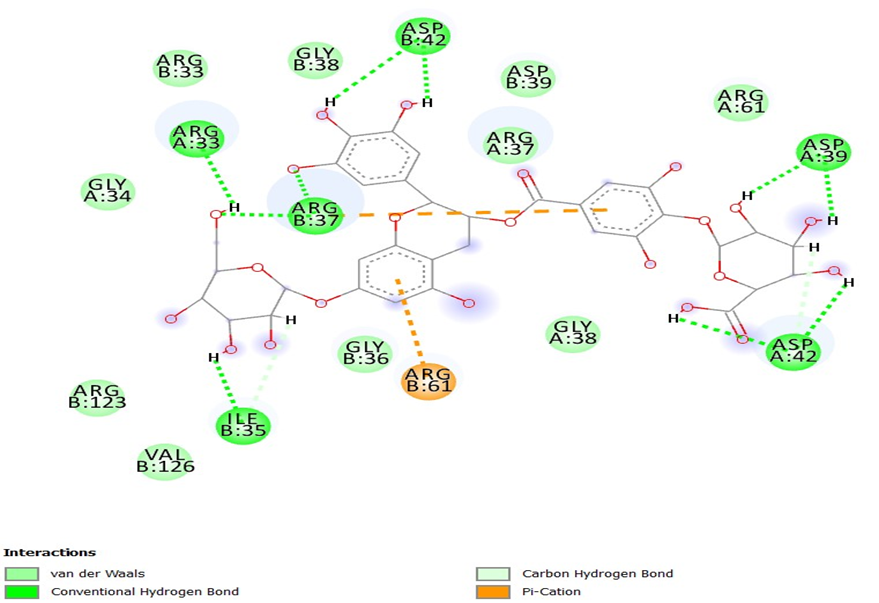
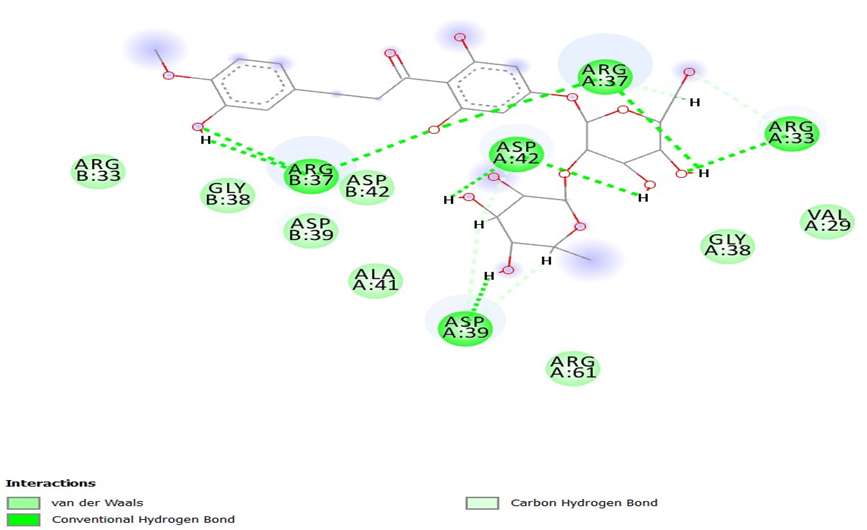
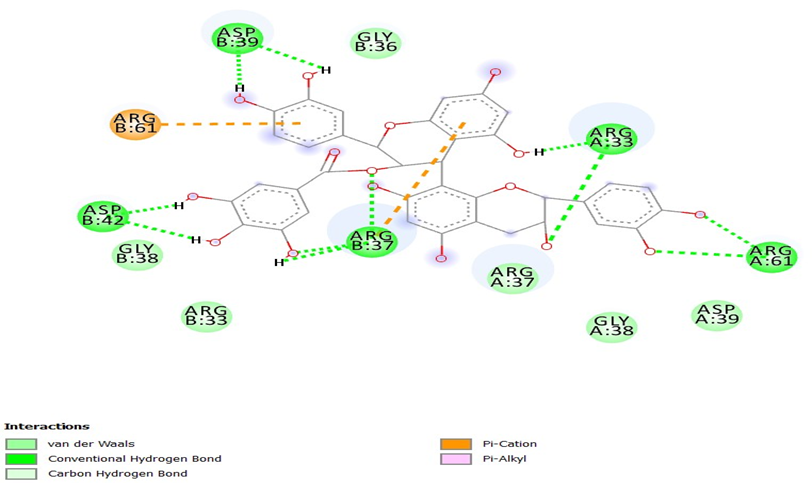
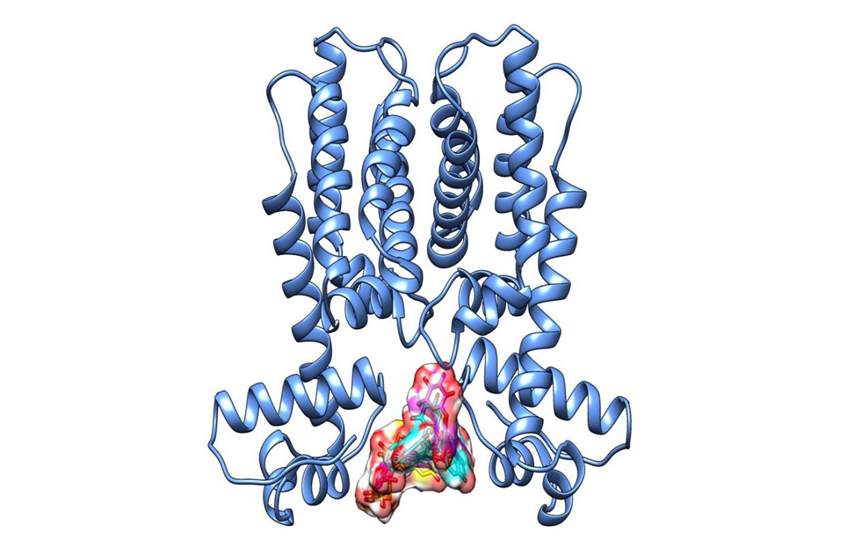
The in-sico results, the best two compounds, EGCG and Neohesperidin, were carried ahead for in-vitro research. The minimum inhibitory concentration (MIC) of EGCG and Neohesperidin against vibrio cholera were determined to be 400g/ml and 25 mg/ml, respectively.
Figure 5 depicts the inhibition of EPS generation and biofilm formation by EGCG at sub-MIC values. Figure 6 shows concentration-dependent decreases in EPS generation and the formation of vibrio cholera biofilms. In vibrio cholera, EGCG suppressed EPS synthesis by up to 62 percent, whereas Neohesperidin inhibited EPS production by up to 56 percent. EGCG inhibited biofilm formation in vibrio cholera by 72 percent, while Neohesperidin inhibited biofilm formation by 67 percent.
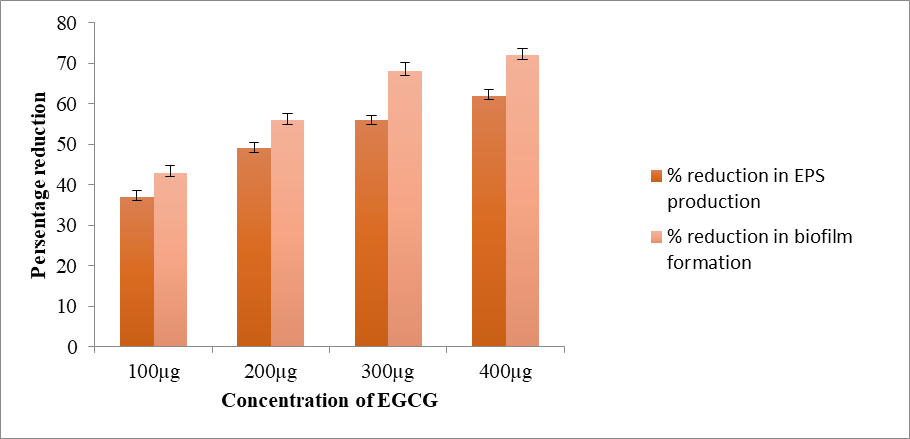
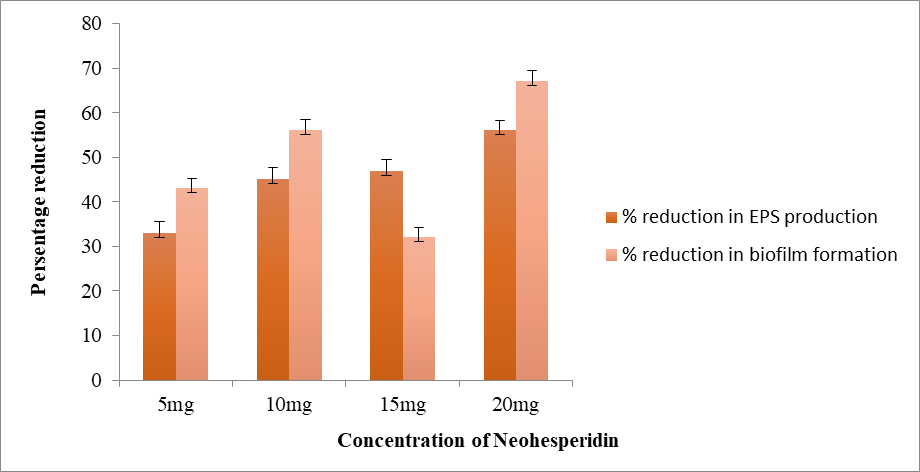
Discussion
Vibrio cholerae is a Gram-negative bacterium that lives in saline coastal waters and estuaries and is the cause of cholera in some cases (Clemens et al., 2017). Cholera toxin (CT) and toxin, two virulence factors, coregulated pilus. Cholera is caused by the bacteria Vibrio cholerae (TCP), which is linked to cholera the most. Cholera is a life-threatening disease that can be readily avoided and treated. Some strains of V. cholerae are infectious to humans and produce the deadly disease cholera, which can be contracted by eating raw or undercooked seafood. (Lutz, Carla et al., 2013)
Resveratrol is a phytoalexin and a natural polyphenol (3,5,4-trihydroxy-trans-stilbene). It's mostly found in the skins of grapes, berries, and other fruits, and it's also a key ingredient in red wine. Medicinal qualities such as anti - inflammatory, antiviral, antioxidant, antibacterial, neuroprotective, and a powerful cancers chemopreventive have been reported in various studies (Baur and Sinclair 2006). There has been very little research done to demonstrate its antipathogenic activity. Swarming inhibition and virulence factor expression in Proteus mirabilis were described by Wang et al. (2006), and Thimothe et al (2007). Treatment with resveratrol reduced the virulence features of Streptococcus mutans. Morinaga et al. (2010) found that resveratrol administration inhibited cholera toxin-induced cAMP buildup in Vero cells, and Coenye et al. The same's biofilm inhibitory activity against Propionibacterium acnes was reported in 2012.
As many microbes evolve resistance to currently available medications, the demand for new therapies that can be employed as a replacement grows by the day. Instead of medications that kill bacteria or disrupt pathogens, contemporary techniques focus on interfering with and inhibiting pathogen pathogenicity. Interfering with QS activity, which is required for cell-cell communication, could be an effective strategy for bacteria that build biofilm. Twenty-four bioactive chemicals from various natural food sources were selected from the PubChem database and submitted to molecular docking studies using AutoDock to determine their anti-quorum sensing action on the Vibrio cholera HapR target.In my studies the final docking score of top ranked 10 Compounds have been listed in table (2).Top two molecular docking score is Epigallocatechin3gallate, Neohesperidin.These compounds will be taken for in vitro studies which has antimicrobial activity.
Quorum-quenching actions of EGCG and Neohesperidin were also demonstrated in vitro. To overcome antibiotic resistance, these chemicals could be used as a quorum sensing inhibition (QSI) based medication against vibrio cholera infections disseminated through hospitals.
Conlusion
The current in silico study of twenty-four various bioactive compounds generally found in various sources of food against by the vibrio cholerae receptor protein HapR found that ten molecules had similar high docking scores with the known inhibitor and therefore can be used as potential inhibitors of vibrio cholerae biofilm formation. To confirm its potential, compounds with high fitness ratings should be suggested for future in vitro and in vivo studies. For a better understanding of these quorum quenching molecules and their mechanism of action, more gene expression and molecular interaction investigations are required.
Significance Of the Study
V. cholerae produces and responds to four autoinducers (Jung et al., 2015, 2016). Every autoinducer binds to its cognate kinase at high cell density, causing the LuxO regulator to be dephosphorylated (Jung et al., 2015). This pathogen produces a number of important virulence factors, including cholera toxin (CT), toxin co-regulated pilus (TCP), flagellum, and cholera hemolysin, which leads to death.
Author Contributions
All the authors contributed equally for this research work.
Funding source: Nil
Conflict of interest
The authors have no conflict of interest.
References
- Baur, J.A., Sinclair, D.A., (2006). Therapeutic potential of resveratrol: the in vivo evidence.Nature Reviews Drug Discovery 5, 493-506.https://doi.org/10.1016/j.phymed. 2013.09.010.
- Clemens, J. D., Nair, G. B., Ahmed, T., Qadri, F., and Holmgren, J. (2017). Cholera. Lancet 390, 1539–1549. doi: 10.1016/S0140-6736(17)30559-7.
- Gao H., Xu J., Lu X., Li J., Lou J., Zhao H., et al. (2018). Expression of hemolysin is regulated under the collective actions of HapR, Fur, and HlyU in Vibrio cholerae El Tor serogroup O1. Front. Microbiol. 9:13 doi:10. 10.3389/fmicb.2018.01310.
- Goodsell DS, Sanner MF, Olson AJ, Forli S (August 2020).
- Gupta G (2020-05-26).
- https://journals.plos.org/plospathogens/article?id=10.1371/journal.ppat.1004837
- Jung, S.A., Hawver, L.A., and Ng, W.-L. (2016) Parallel quorum sensing signaling pathways in Vibrio cholerae. Curr Genet 62: 255–260.doi:10.1007/s00294-015-0532-8.
- Kierek, K., Watnick, P.I., (2003). Environmental determinants of Vibrio cholerae biofilm development. Applied and Environmental Microbiology 69, 5079–5088.doi.org/10.1128/AEM.69.9.5079-5088.2003.
- Lutz, Carla; Erken, Martina; Noorian, Parisa; Sun, Shuyang; McDougald, Diane (2013).
- Morinaga, N., Yahiro, K., Noda, M., (2010). Resveratrol, a natural polyphenolic compound, inhibits cholera toxin-induced cyclic AMP accumulation in vero cells. Toxicon 56, 29–35.doi.org/10.1016/j.toxicon.2010.03.009.
- Ng, W.-L. and Bassler, B.L. (2009) Bacterial Quorum-Sensing Network Architectures. Annu Rev Genet 43: 197– 222. doi: 10.1146/annurev-genet-102108-134304.
- Papenfort, K. and Bassler, B.L. (2016) Quorum sensing signal–response systems in Gram-negative bacteria. Nat Rev Microbiol 14: 576–588.
- Park H, Lee J, Lee S (November 2006).
- Sambanthamoorthy, K., Sloup, R.E., Parashar, V., Smith, J.M., Kim, E.E., Semmelhack, M.F., Neiditch, M.B., Waters, C.M., (2012). Identification of small molecules that antagonize diguanylatecyclase enzymes to inhibit biofilm formation. Antimicrobial Agents and Chemotherapy 56, 5202–5211. Doi.org/10.1128/AAC.01396-12.
- Schames JR, Henchman RH, Siegel JS, Sotriffer CA, Ni H, McCammon JA (April 2004).
- Shao, Y. and Bassler, B.L. (2014) Quorum regulatory small RNAs repress type VI secretion in Vibrio cholerae. Mol Microbiol 92: 921–930.doi.org/10.1111/mmi.12599.
- Sousa SF, Fernandes PA, Ramos MJ (October 2006).
- Sydnor ERM and Perl TM. “Hospital Epidemiology and Infection Control in Acute-Care Settings”. Clinical Microbiology Reviews 24.1 (2011): 141-173.doi.org/10.1128/CMR.0007-10
- Tamayo, R., Patimalla, B., Camilli, A., (2010). Growth in a biofilm induces a hyperinfectious phenotype in Vibrio cholerae. Infection and Immunity 78, 3560–3569 Doi.org/10.1128/IAI.00048-10.
- Tsou, A.M., Cai, T., Liu, Z., Zhu, J., and Kulkarni, R. V. (2009) Regulatory targets of quorum sensing in Vibrio cholerae: evidence for two distinct HapR-binding motifs. Nucleic Acids Res 37: 2747–2756.doi.org/10.1093/nar/gkp121.
- Thimothe, J., Bonsi, I.A., Padilla-Zakour, O.I., Koo, H., (2007). Chemical characterization of red wine grape (Vitis vinifera and Vitis interspecific hybrids) and pomace phenolic extracts and their biological activity against Streptococcus mutans. Journal of Agricultural and Food Chemistry 55, 10200–10207.doi.org/10.1021/jf0722405.
- Tamayo, R., Patimalla, B., Camilli, A., (2010). Growth in a biofilm induces a hyperinfectious phenotype in Vibrio cholerae. Infection and Immunity 78, 3560–3569 doi.org/10.1128/IAI.00048-10.
- Watve, S.S., Thomas, J., and Hammer, B.K. (2015) CytR Is a Global Positive Regulator of Competence, Type VI Secretion, and Chitinases in Vibrio cholerae. PLoS One 10: e0138834.doi.org/10.1371/journal.pone.0138834.
- Wang, L., Brown, S.J., (2006). BindN: a web-based tool for efficient prediction of DNA and RNA binding sites in amino acid sequences. Nucleic Acids Research 34, W243–W248.doi.org/10.1093/nar/gkl298.
- Yang, M., Frey, E.M., Liu, Z., Bishar, R., Zhu, J., (2010). The virulence transcriptional activator AphA enhances biofilm formation by Vibrio cholerae by activating expression of the biofilm regulator VpsT. Infection and Immunity 78, 697–703.doi.org/10.1128/IAI.00429-09.
- Zimmer, K.R., Blum-Silva, C.H., Souza, A.L.K., WulffSchuch, M., Reginatto, F.H., Pereira, C.M.P., Macedo, A.J. and Lencina, C.L., (2014). doi.org/10.1089/jmf.2013.0037.


